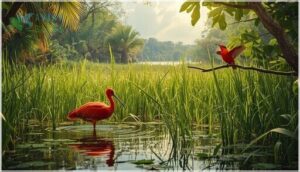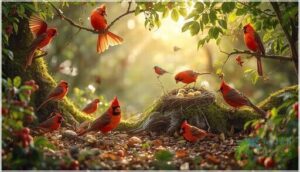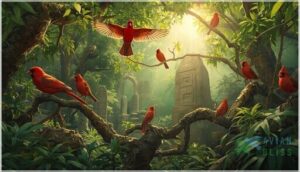This site is supported by our readers. We may earn a commission, at no cost to you, if you purchase through links.

These splashes of color don’t just signal beauty; they shape how red birds live, where they flourish, and even how they connect with each other. As you discover the secrets behind these living sparks, you’ll start to see why spotting one in your backyard feels anything but ordinary.
Table Of Contents
- Key Takeaways
- What Makes a Bird Red?
- Common Red Bird Species Worldwide
- Red Bird Habitats and Distribution
- Diet, Behavior, and Breeding of Red Birds
- Conservation and Cultural Significance
- Frequently Asked Questions (FAQs)
- What are the different types of Red Birds?
- What is a red bird?
- What birds are red in North America?
- Are there any Red Birds?
- What are those red birds called?
- Is seeing a red bird good luck?
- What is the difference between a cardinal and a red bird?
- Are red birds angels?
- How do I identify red birds in flight?
- Are there any all-red bird species?
- Conclusion
Key Takeaways
- Red birds get their vibrant color mainly from carotenoids in their diets, which are chemically transformed by specialized genes and metabolic processes.
- Habitat variety and adaptability allow red birds to thrive in forests, open country, and even urban spaces, but habitat loss and climate change pose serious threats.
- Males usually have the brightest red plumage to attract mates, while females are duller for camouflage and nesting protection.
- Feeding choices, seasonal changes, and cultural symbolism all shape your experience spotting and connecting with red birds in the wild or your own backyard.
What Makes a Bird Red?
You might think a red bird is simply born that way, but the story behind that vibrant plumage is more complex than you’d expect. The vivid crimson, scarlet, or ruby hues you see are shaped by what these birds eat, how their bodies process nutrients, and even the time of year.
Let’s break down the key factors that give red birds their striking color.
Pigments and Diet Influencing Red Plumage
Behind every stunning red bird you spot, there’s a fascinating story of diet and genetics at work. Most red plumage originates from dietary carotenoids—pigments absorbed from berries and colorful fruits—then transformed by specialized genes like CYP2J19 into vivid ketocarotenoids.
- Canthaxanthin creates the vivid scarlet in ibises and tanagers
- Genetic conversion amplifies pigment intensity over 1,000-fold
- Pigment variation differs dramatically between species and individuals
- Environmental factors and feather biochemistry fine-tune final coloration
Scientists have discovered that gene CYP2J19 is critical for producing red plumage.
Role of Metabolism in Coloration
Once you absorb pigments from your diet, your metabolism becomes the artist. Carotenoid transformation through specialized enzymes converts yellow pigments into vivid reds—over 90% of red coloration depends on enzymatic oxidation by CYP2J19. Research indicates that carotenoid pigments are key to this color transformation in birds.
Mitochondrial function directly links feather redness to cellular respiration, while oxidative stress markers reveal metabolic health. Your bird’s metabolic pathways determine whether those dietary carotenoids become stunning plumage or remain stored.
| Metabolic Process | Role in Coloration | Example Impact |
|---|---|---|
| CYP2J19 enzyme activity | Converts yellow to red pigments | 1000-fold expression increase |
| Mitochondrial respiration | Powers oxidation reactions | Links color to cellular health |
| Genetic regulation | Controls enzyme production | 102 liver genes differentially expressed |
| Antioxidant pathways | Balances oxidative stress | Maintains plumage intensity |
Seasonal Changes in Plumage Color
Metabolism sets the stage, but plumage color shifts dramatically through the year. You’ll see Northern Cardinals reach peak brilliance by midwinter as feather tips wear away, revealing intense pigment deposition beneath. Scarlet Tanagers transform in spring through hormonal influence and molting cycles.
Three key forces drive these color variations:
- Environmental abrasion from wind and foliage exposes vivid feathers
- UV exposure degrades outer layers, enhancing underlying coloration
- Seasonal molt timing replaces worn feathers before breeding displays
Differences Between Male and Female Red Birds
Sexual dimorphism separates males from females dramatically in red birds. Male birds display vibrant red plumage to improve mating displays and territorial signaling, while female birds adopt muted browns and grays for color camouflage during nesting roles.
Plumage brightness correlates directly with reproductive success—males with intense reds secure better territories. Dichromatism measures reveal males consistently show 70–85% more saturated coloration than their female counterparts across species.
Common Red Bird Species Worldwide
Red birds aren’t just found in your backyard—they’re scattered across continents, from the tropical Americas to the diverse landscapes of Australia and Asia. Each region hosts its own distinctive species, adapted to local climates and ecosystems.
Let’s look at some of the most striking red birds you’ll encounter beyond North America’s familiar faces.
Red Birds of Central and South America (Vermilion Flycatcher, Scarlet Ibis, Etc.)
Central and South America host some of the world’s most striking red bird species across their diverse tropical ecosystems. You’ll find populations thriving from Mexico’s northern deserts to Brazil’s coastal wetlands, though habitat remoteness plays a key role in their survival.
- Vermilion Flycatcher: This aerobatic insectivore shows impressive urban adaptation, nesting in parks and golf courses despite a troubling 1.7% annual decline across its 5-50 million individual range since 1966
- Scarlet Ibis: Its vivid red plumage comes directly from carotenoids in wetland crustaceans, with highest concentrations inhabiting Venezuela and Colombia’s remote Llanos grasslands
- Breeding behavior: Both species exhibit distinct nesting strategies—flycatchers build cup-shaped nests with 14-day incubation periods, while ibises nest colonially in mangroves with 21-24 day incubation
- Regional patterns: Texas flycatcher populations decline faster (2.6% yearly) than Arizona’s, which actually increase 2.2% annually, showing how localized conditions affect conservation
- Diet specialization: These bird species in Central America and South America have evolved precise feeding strategies, from mid-air insect catches to probing mudflats for aquatic prey
Australian and Asian Red Birds (Crimson Rosella, Red Avadavat, Etc.)
In the patchwork of Asian habitats and Australian forests, Crimson Rosellas flash vibrant reds, their plumage shaped by a diverse rosella diet and internal pigment synthesis. Meanwhile, Red Avadavats—often victims of avadavat trade and habitat loss—bring bursts of color to grasslands.
Observing these bird species in Australia and Asia, you’ll notice subspecies diversity, vivid displays, and keen adaptation.
Red Bird Habitats and Distribution
Red birds don’t just stick to one type of landscape—they’ve adapted to an impressive range of environments across the globe. From dense forest canopies to sun-baked scrublands, each species has carved out its own niche based on food availability, nesting sites, and climate.
Let’s explore where you’re most likely to encounter these vibrant birds in the wild.
Forests, Woodlands, and Mixed Habitats
You’ll find red birds thriving in deciduous forests, coniferous forests, and open woodlands, where forest structure dictates species distribution.
Habitat fragmentation threatens specialists like Scarlet Tanagers, which require large interior tracts, while generalists adapt to smaller patches.
Conservation efforts focus on protecting connected habitats, as these bird habitats support key ecological roles from insect control to ecosystem monitoring across diverse woodland environments.
Dry and Open Country Environments
You’ll spot red birds adapted to open areas where heat and exposure demand specialized thermoregulation adaptations—lighter plumage reflects sunlight while efficient water metabolism counters scarcity.
Species like the Vermilion Flycatcher thrive in these challenging landscapes through distinct foraging strategies and nesting behavior:
- Grasslands and semi-arid scrublands with sparse vegetation
- Agricultural fields providing mixed seed eater habitat
- Conspicuous perching on exposed branches for prey spotting
- Ground-level nesting in minimal cover despite predation risks
- Climate impacts reducing survival rates up to 50% in some populations
Habitat fragmentation threatens these open-country specialists as bird habitat quality declines.
Regional Distribution Patterns by Species
You’ll notice dramatic bird distribution differences when tracking red species across continents—Northern Cardinals expanded northward throughout the 20th century, while Scarlet Ibis colonies concentrate in Venezuela’s Llanos wetlands.
Habitat specificity shapes these range and distribution patterns of birds: Crimson Rosellas occupy sea-level to treeline elevations in southeastern Australia, whereas Vermilion Flycatchers show distinct migration patterns between breeding and wintering grounds, with regional density peaks in riparian corridors.
Adaptability to Urban and Backyard Settings
Red birds thrive in urban environments where you’d least expect them. Backyard bird feeders with black oil sunflower seeds attract Northern Cardinals and House Finches, which adapt vocalizations to overcome city noise.
Urban survival rates actually exceed rural populations for some species, thanks to year-round resource availability and city green spaces. Your habitat can support bird watching opportunities while contributing to genetic mutations favoring adaptation.
Diet, Behavior, and Breeding of Red Birds
Red birds lead fascinating lives shaped by what they eat, how they interact with others, and when they choose to breed. Their daily routines shift with the seasons, from foraging strategies that change throughout the year to dramatic courtship displays that catch your eye.
Let’s explore the key aspects of their diet, behavior, and breeding habits that make these crimson-plumed birds so interesting to observe.
Typical Diets and Feeding Behaviors
Nutritional adaptability defines how you’ll observe red birds thriving across diverse ecosystems. Seed preferences vary considerably: Cardinals target sunflower and safflower varieties at feeder visits, while Crimson Rosellas consume eucalyptus seeds.
Insect catching dominates Vermilion Flycatcher foraging strategies, spending 4-11% of daylight pursuing aerial prey. Diet and bird coloration connect directly—carotenoid-rich foods intensify plumage intensity.
Understanding bird feeding habits reveals seasonal shifts: increased protein during breeding, seed reliance during winter scarcity.
Mating Displays and Nesting Habits
Courtship rituals among red birds showcase dramatic aerial displays and vibrant plumage signals. Male Cardinals perform song-dance sequences to attract mates, with redder males breeding earlier and securing higher-quality territories. Vermilion Flycatchers execute fluttery chest displays mid-flight.
Nesting behaviors vary: Cardinals build cup-shaped structures 1-15 feet high in shrubs, while Crimson Rosellas select tree hollows up to 30 meters elevated, demonstrating species-specific adaptations for breeding success.
Migration and Seasonal Movements
After breeding season wraps up, you’ll witness striking bird migration patterns as red species begin epic journeys. Migration patterns reveal impressive adaptations:
- Distance champions: Rufa Red Knots travel 9,300 miles one-way, while Scarlet Tanagers cross the Gulf of Mexico nocturnally
- Stopover ecology: Central American sites enable 30% body mass increases before long flights
- Seasonal timing shifts: Climate change disrupts food availability at breeding grounds, affecting survival
Flight adaptations and habitat use during migration determine success across diverse range and distribution of birds.
Social and Territorial Behaviors
As migration ends, watch how bird social behaviors take center stage. Pair bonding is strong—Northern Cardinals might keep the same mate all year. Territorial defense becomes visible, with males displaying aggressive behavior to guard space. Social hierarchy influences breeding success, while some species form flocks for feeding. Here’s what it might look like:
| Behavior Type | Example in Red Birds |
|---|---|
| Aggressive Defense | Cardinal chases rivals |
| Pair Bonding | Allopreening, duet calls |
Conservation and Cultural Significance
Caring about red birds means looking at both their future and the stories we tell about them. Their world is shaped by shifting habitats, conservation efforts, and cultural meaning, all woven together.
Here’s what you’ll want to know next.
Threats and Conservation Status of Red Birds
You see the world’s red birds adapting like artists on a shifting canvas, yet their survival hangs in the balance. Four threats paint the scene:
Red birds move like living art through a world of uncertainty, their survival threatened by relentless change and mounting dangers
- Relentless habitat loss stretches populations thin
- Climate change disrupts breeding and food
- Predation impact rises with urbanization
- Bird conservation status faces ongoing challenge from human-caused hazards
Population trends echo the need for vigilance.
Efforts for Protection and Monitoring
Through habitat restoration across threatened regions and ongoing population surveys, you help safeguard bird ecological roles. Technology, from drone counts to AI identification, sharpens monitoring of conservation status—even in remote sites.
Policies now demand urgent action, but real progress hinges on your citizen involvement, shaping data collection and stewardship that can blunt the impacts of habitat loss on bird populations worldwide.
Symbolism and Meaning of Red Birds in Cultures
Crimson plumage in red birds doesn’t just stand out against green leaves; it carries weight as a spiritual messenger, love symbol, and omen. Across bird species and cultures—Ojibwe, Cherokee, even Renaissance art—folklore and myth credit these birds with powerful meaning.
Cardinals and tanagers embody loyalty, transformation, and hope, stitching themselves into literature, textile art, and everyday meaning.
Attracting Red Birds to Your Backyard
Picture your backyard alive with flashes of scarlet—attracting red birds is about choice and care. Offer stable, broad platform feeders packed with sunflower seeds, surround them with native plants for both food and cover, and keep water sources fresh.
Add winter shelter with evergreens, and practice thoughtful predator control. That’s how backyard bird watching becomes a vivid, rewarding ritual.
Frequently Asked Questions (FAQs)
What are the different types of Red Birds?
Red bird species span a vibrant spectrum, from the iconic Cardinalidae family and Tanager classification to Crossbill variations, tropical species like scarlet ibis, and Asian finches—a global mosaic for any red bird identification guide or field enthusiast.
What is a red bird?
Like fire catching the edge of a dawn sky, Defining Red in birds comes down to Bird Taxonomy and Plumage Variations—red bird families are identified not just by striking color, but by unique traits, behaviors, and identification features.
What birds are red in North America?
When you want to spot vibrant North American bird species, start with Cardinal Identification—Northern Cardinals charm with bold red, while Tanager Varieties, distinct Finches, Crossbill Types, and unique Grosbeak Distinctions round out this red bird species lineup.
Are there any Red Birds?
Yes, you’ll find a surprising variety of birds featuring red plumage across continents. Bird identification often starts with color, and red birds—from cardinals to tanagers—highlight the remarkable species diversity and global distribution found in red birding.
What are those red birds called?
You might hear many birds called “red birds,” but it’s rarely so simple. From Northern Cardinals to Scarlet Tanagers, red plumage varies with bird naming, regional differences, and seasonal changes.
So, accurate Red bird ID always demands careful, local bird identification.
Is seeing a red bird good luck?
Spotting a red bird is often tied to Cultural Superstitions and Spiritual Messages. Many interpret these striking bird species as omens of good luck, with traditions rooting Bird Symbolism in hope, transformation, and Positive Affirmations.
What is the difference between a cardinal and a red bird?
If you’re looking to separate the real from the red, think of the Northern Cardinal as the poster-bird for Cardinal identification—crest, black mask, thick beak—while “red birds” span species, plumage comparison, calls, and behavior beyond cardinals.
Are red birds angels?
Spiritual messengers to many, red birds aren’t angels in a literal sense, but their vivid presence inspires rich cultural symbolism, emotional interpretations, and folklore beliefs.
Weaving bird behavior and modern interpretations into ongoing conversations, these symbols continue to explore themes of hope and meaning.
How do I identify red birds in flight?
Isn’t it curious how a single flash of color in flight can mean many things?
For bird identification, focus on plumage variations, flight patterns, audible calls, size comparison, and habitat clues—each tells its own story midair.
Are there any all-red bird species?
Some Defining All-Red bird species truly stand out: Summer Tanagers, Scarlet Ibises, and (often) Vermilion Flycatchers.
Their plumage uniformity results from genetic mutations, seasonal molting, and dietary influence—fascinating examples of red birds and identification in action.
Conclusion
Spotting, studying, admiring—these are your invitations to witness the daily drama of red birds. They arrive as messengers of biology, ambassadors of habitat, reminders of nature’s give and take.
Let your curiosity follow them across continents and seasons, from tangled forests to city streets. In every feather, you’ll find layers of science, resilience, and wonder.
The next time scarlet wings flash overhead, you’ll know the story behind the color—and appreciate their world with new eyes.








